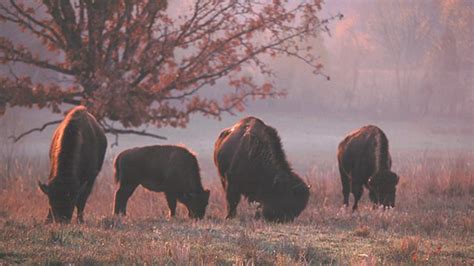
After nearly vanishing from North American landscapes, bison are making a triumphant return to tribal lands, symbolizing a resurgence of Indigenous culture, ecological restoration, and food sovereignty.
For generations, the absence of bison has represented a painful chapter in Indigenous history, marked by forced displacement, cultural erasure, and ecological disruption. The profound connection between Indigenous communities and bison is now being rekindled as herds are reintroduced to ancestral territories, revitalizing not only the ecosystem but also the spiritual and economic well-being of these communities. The InterTribal Buffalo Council (ITBC) has been instrumental in this effort, working with 82 tribes across 20 states to restore bison populations. “The buffalo are part of us. They are our relatives. When the buffalo disappeared, it left a hole in our hearts,” says Ervin Edwards, an ITBC board member and a tribal elder from the Cheyenne and Arapaho Tribes in Oklahoma.
A Symbol of Cultural and Spiritual Significance
The relationship between Indigenous peoples and bison stretches back millennia. Bison provided sustenance, clothing, shelter, and tools, becoming deeply interwoven with Indigenous cultures and spiritual practices. The systematic extermination of bison in the 19th century was a deliberate attempt to undermine the livelihoods and sovereignty of Native American tribes. The return of the bison is therefore much more than an ecological endeavor; it is a powerful act of cultural reclamation and spiritual healing.
The spiritual significance of bison is deeply rooted in Indigenous creation stories, ceremonies, and traditions. Bison are often seen as sacred beings, representing strength, resilience, and abundance. Their presence on tribal lands is believed to restore balance and harmony to the environment and the community. “They’re coming home. They’re part of our identity, who we are as Native people,” says Edwards, encapsulating the profound emotional and cultural significance of this restoration.
Ecological Restoration and Biodiversity
Bison are keystone species, playing a critical role in maintaining the health and diversity of grassland ecosystems. Their grazing habits promote plant diversity, prevent shrub encroachment, and create habitat for other wildlife. Bison also contribute to nutrient cycling through their waste, enriching the soil and supporting plant growth.
The reintroduction of bison can help restore degraded rangelands, improve water infiltration, and sequester carbon in the soil, mitigating the effects of climate change. Managed grazing by bison can also reduce the risk of wildfires by removing excess vegetation. “The buffalo are natural landscapers. They graze in a way that promotes healthy grasslands,” explains Troy Heinert, executive director of the ITBC.
Food Sovereignty and Economic Empowerment
For many Indigenous communities, food security remains a significant challenge. The return of bison offers an opportunity to enhance food sovereignty by providing a sustainable source of protein and reducing reliance on processed foods. Bison meat is a lean and nutritious alternative to beef, and it can be an important source of income for tribal communities.
Tribes are developing sustainable bison ranching operations that prioritize animal welfare and environmental stewardship. These operations create jobs and economic opportunities for tribal members, while also promoting cultural revitalization and community pride. The ITBC provides technical assistance and training to tribes interested in starting or expanding their bison programs.
Challenges and Opportunities
While the bison restoration movement has gained momentum, it faces several challenges. One of the biggest obstacles is the limited availability of suitable habitat. Many tribal lands are fragmented or degraded, making it difficult to support large bison herds.
Another challenge is the risk of disease transmission between bison and domestic cattle. Brucellosis and other diseases can negatively impact bison populations and create conflicts with ranchers. The ITBC works with tribes and government agencies to develop strategies for managing disease risk and promoting coexistence between bison and cattle.
Despite these challenges, the bison restoration movement holds tremendous promise for Indigenous communities and the environment. By working together, tribes, government agencies, and conservation organizations can ensure that bison thrive on tribal lands for generations to come. “We have a responsibility to bring them back and take care of them, just like they took care of us for thousands of years,” says Edwards.
A Model for Collaborative Conservation
The bison restoration movement is a powerful example of collaborative conservation. It demonstrates the importance of partnerships between Indigenous communities, government agencies, and conservation organizations in achieving shared goals.
The ITBC plays a crucial role in facilitating these partnerships by providing a forum for tribes to share information, coordinate efforts, and advocate for policies that support bison restoration. The organization also works with federal agencies, such as the U.S. Fish and Wildlife Service and the National Park Service, to develop and implement bison management plans.
The success of the bison restoration movement is a testament to the resilience and determination of Indigenous communities. It is also a reminder of the importance of restoring ecological balance and cultural connections in a rapidly changing world.
The Future of Bison Restoration
The future of bison restoration depends on continued collaboration, innovation, and investment. Tribes need access to resources and technical assistance to manage their bison herds sustainably. Government agencies need to support tribal bison programs and address the challenges of habitat fragmentation and disease risk.
Conservation organizations can play a key role by providing funding, research, and advocacy support. By working together, we can ensure that bison continue to thrive on tribal lands and contribute to the health and well-being of Indigenous communities and the environment.
The return of the bison is not just a story of ecological restoration; it is a story of cultural revitalization, economic empowerment, and spiritual renewal. It is a story of hope for a future where Indigenous communities are able to reclaim their rightful place as stewards of the land and keepers of the bison.
Expanding the Narrative: Deep Dive into Bison Restoration
The resurgence of bison on Indigenous lands represents a multifaceted triumph, intertwining ecological restoration, cultural revitalization, and the pursuit of food sovereignty. To fully grasp the significance of this movement, it’s crucial to explore the historical context, the ecological impact, the socio-economic benefits, and the ongoing challenges.
Historical Trauma and the Bison’s Demise
The near-extinction of the bison in the late 19th century wasn’t merely an ecological disaster; it was a calculated strategy to subjugate Native American tribes. As the primary source of food, clothing, and shelter, the bison were integral to the Indigenous way of life. Their systematic slaughter, encouraged by the U.S. government, aimed to dismantle tribal economies and force assimilation.
By the late 1880s, the bison population plummeted from an estimated 30-60 million to fewer than 1,000. This decimation resulted in widespread starvation, disease, and cultural disruption among Native American communities. The loss of the bison severed a deep spiritual connection, leaving a void that continues to resonate today.
“The intentional eradication of the buffalo was a tool of war used against our people,” explains Chief Joseph Standing Bear of the Cheyenne River Sioux Tribe. “It was an attempt to destroy our way of life and break our spirit.”
Ecological Keystone: Bison’s Role in Grassland Health
Bison are more than just large herbivores; they are ecosystem engineers that shape and maintain the health of grasslands. Their grazing habits promote biodiversity, prevent the dominance of certain plant species, and create a mosaic of habitats that support a wide range of wildlife.
Unlike cattle, which tend to graze selectively and concentrate their impact on certain areas, bison graze more evenly, distributing their effects across the landscape. Their wallowing behavior creates depressions in the soil that collect water, providing habitat for amphibians and invertebrates. Their dung fertilizes the soil, promoting plant growth and nutrient cycling.
Research has shown that bison grazing can increase plant diversity, improve soil health, and enhance carbon sequestration in grasslands. By restoring bison to their native range, we can revitalize degraded ecosystems and mitigate the effects of climate change.
“Bison are essential to the health of our grasslands,” says Dr. Lauren Porensky, a rangeland ecologist at Colorado State University. “They create a more diverse and resilient ecosystem that benefits both wildlife and humans.”
Food Sovereignty and Economic Opportunity
The return of bison offers a pathway to food sovereignty for Indigenous communities, reducing their reliance on external food systems and promoting self-determination. Bison meat is a nutritious and sustainable source of protein, lower in fat and higher in iron than beef.
Tribes are developing bison ranching operations that prioritize animal welfare, environmental sustainability, and cultural values. These operations create jobs and economic opportunities for tribal members, providing a source of income and building community wealth.
The InterTribal Buffalo Council (ITBC) plays a crucial role in supporting tribal bison programs, providing technical assistance, training, and marketing support. The ITBC also works to promote the consumption of bison meat and educate consumers about the benefits of supporting tribal bison ranching.
“Bringing back the buffalo is about more than just food,” says Troy Heinert, Executive Director of the ITBC. “It’s about restoring our connection to the land, reclaiming our cultural identity, and creating economic opportunities for our people.”
Challenges and Mitigation Strategies
Despite the progress made in bison restoration, significant challenges remain. Habitat loss, disease transmission, and conflicts with livestock producers are among the major obstacles.
Habitat Loss and Fragmentation: As human populations grow and land is converted for agriculture and development, suitable habitat for bison is becoming increasingly scarce. Protecting and restoring grasslands is essential for supporting healthy bison populations.
Disease Transmission: Bison are susceptible to several diseases, including brucellosis and Johne’s disease, which can be transmitted from domestic cattle. Implementing strict biosecurity measures and maintaining a buffer between bison and cattle herds is crucial for preventing disease outbreaks.
Conflicts with Livestock Producers: Some ranchers fear that bison will compete with cattle for forage and transmit diseases. Building trust and fostering collaboration between tribal bison producers and non-tribal ranchers is essential for minimizing conflicts.
Ongoing Efforts and Future Directions
The bison restoration movement is a long-term endeavor that requires sustained commitment and collaboration. Ongoing efforts include:
-
Habitat Restoration: Restoring degraded grasslands through prescribed burning, invasive species control, and native plant restoration.
-
Disease Management: Implementing surveillance programs to monitor bison for diseases and developing strategies for preventing disease transmission.
-
Genetic Conservation: Maintaining genetic diversity within bison populations to ensure their long-term health and adaptability.
-
Community Engagement: Educating the public about the ecological and cultural significance of bison and promoting the consumption of bison meat.
-
Policy Advocacy: Advocating for policies that support bison restoration and protect tribal sovereignty.
The future of bison restoration depends on our collective ability to address these challenges and work together to create a future where bison thrive on tribal lands and contribute to the health and well-being of Indigenous communities and the environment.
The Bison’s Symbolic Resonance: More Than Just an Animal
The return of the bison to Indigenous lands transcends simple ecological restoration. It represents a profound reclaiming of cultural heritage, a spiritual reconnection, and a significant stride towards self-determination. For generations, the absence of the bison symbolized the forced displacement, cultural erasure, and economic hardship inflicted upon Native American tribes. The bison’s resurgence, therefore, carries a weight of historical significance and a beacon of hope for the future.
Spiritual Reconnection
In numerous Indigenous cultures, the bison is considered a sacred animal, deeply interwoven with creation stories, ceremonies, and spiritual practices. The animal represents strength, resilience, abundance, and a profound connection to the land. The slaughter of the bison was not only a physical blow but also a spiritual one, disrupting a sacred relationship that had existed for millennia.
The return of the bison signifies a healing process, allowing Indigenous communities to reconnect with their ancestral traditions and restore balance to their spiritual well-being. Ceremonies and rituals are being revived, incorporating the bison as a central figure, reinforcing cultural identity, and fostering a sense of belonging.
“The buffalo is our life, our culture, and our connection to the Creator,” says Ervin Edwards. “When the buffalo returns, our spirit returns.”
Cultural Revitalization
The bison provided sustenance, clothing, shelter, and tools – essentially, the building blocks of Indigenous cultures. Traditional skills and knowledge associated with the bison, such as hunting, butchering, tanning hides, and crafting tools, were passed down through generations. With the bison’s disappearance, much of this cultural knowledge was lost or threatened.
The reintroduction of bison is sparking a revitalization of these traditional practices. Young people are learning from elders, ensuring that this cultural heritage is preserved and passed on to future generations. The creation of bison-related art, music, and storytelling is also flourishing, further strengthening cultural identity and pride.
Economic Empowerment
Beyond its cultural and spiritual significance, the return of the bison holds immense economic potential for Indigenous communities. Sustainable bison ranching operations create jobs, generate income, and build community wealth. Bison meat, known for its nutritional value and lean protein content, is gaining popularity in mainstream markets, providing a viable economic opportunity for tribes.
These operations are not simply about profit; they prioritize animal welfare, environmental sustainability, and cultural values. Bison are raised in a manner that respects their natural behaviors and promotes the health of the ecosystem. This approach aligns with Indigenous values of stewardship and sustainability.
Challenges and Considerations
Despite the numerous benefits, the bison restoration movement faces ongoing challenges. These include habitat limitations, disease management, genetic diversity, and the need for collaborative partnerships.
Habitat Limitations: Many tribal lands are fragmented or degraded, posing a challenge to supporting large bison herds. Land restoration efforts and collaborative partnerships with neighboring landowners are crucial for expanding bison habitat.
Disease Management: Diseases such as brucellosis can threaten bison populations and create conflicts with cattle ranchers. Effective disease management strategies, including vaccination programs and biosecurity measures, are essential.
Genetic Diversity: Maintaining genetic diversity within bison populations is crucial for their long-term health and adaptability. Conservation efforts should focus on preserving diverse gene pools and preventing inbreeding.
Collaborative Partnerships: The success of bison restoration depends on strong partnerships between tribes, government agencies, conservation organizations, and private landowners. Collaborative efforts are needed to address habitat limitations, disease management, and other challenges.
A Symbol of Hope
The return of the bison to Indigenous lands is more than just a restoration project; it is a symbol of hope, resilience, and self-determination. It represents a reclaiming of cultural heritage, a spiritual reconnection, and a pathway to economic empowerment. As bison herds thrive once again on tribal lands, they bring with them a renewed sense of pride, identity, and belonging for Indigenous communities. The journey is far from over, but the progress made thus far is a testament to the power of collaboration, cultural preservation, and the enduring spirit of the Indigenous people. The resurgence of the bison serves as a potent reminder of the interconnectedness of culture, ecology, and economy. By restoring the bison to their rightful place, we not only heal the land but also empower Indigenous communities to reclaim their heritage and build a more sustainable future.
Frequently Asked Questions (FAQ)
1. What is the InterTribal Buffalo Council (ITBC) and what is its role in bison restoration?
The InterTribal Buffalo Council (ITBC) is a tribal organization comprised of 82 tribes across 20 states. Its primary mission is to restore bison populations to tribal lands. The ITBC provides technical assistance, training, and resources to tribes interested in starting or expanding their bison programs. The ITBC also facilitates partnerships between tribes, government agencies, and conservation organizations to support bison restoration efforts. “The InterTribal Buffalo Council is a critical partner in helping tribes rebuild their herds and reclaim their cultural heritage,” says Troy Heinert, executive director of the ITBC.
2. Why is the return of bison important to Indigenous communities?
The return of bison is significant to Indigenous communities for several reasons. First, bison are deeply intertwined with Indigenous cultures, spiritual practices, and traditions. The slaughter of bison was a deliberate attempt to undermine Indigenous livelihoods and sovereignty. The return of bison is therefore an act of cultural reclamation and spiritual healing. Second, bison are a sustainable source of food and can enhance food sovereignty for Indigenous communities. Bison meat is a nutritious and lean alternative to beef. Finally, bison ranching operations create jobs and economic opportunities for tribal members, promoting economic empowerment and community pride. As Ervin Edwards states, “The buffalo are part of us. They are our relatives. When the buffalo disappeared, it left a hole in our hearts.”
3. What are the ecological benefits of restoring bison to grasslands?
Bison are keystone species that play a crucial role in maintaining the health and diversity of grassland ecosystems. Their grazing habits promote plant diversity, prevent shrub encroachment, and create habitat for other wildlife. Bison also contribute to nutrient cycling through their waste, enriching the soil and supporting plant growth. Reintroducing bison can help restore degraded rangelands, improve water infiltration, and sequester carbon in the soil, mitigating the effects of climate change. According to Dr. Lauren Porensky, “Bison are essential to the health of our grasslands. They create a more diverse and resilient ecosystem that benefits both wildlife and humans.”
4. What are some of the challenges associated with bison restoration?
Bison restoration faces several challenges, including limited habitat availability, the risk of disease transmission between bison and domestic cattle, and potential conflicts with livestock producers. Many tribal lands are fragmented or degraded, making it difficult to support large bison herds. Diseases like brucellosis can negatively impact bison populations and create conflicts with ranchers. The ITBC works with tribes and government agencies to develop strategies for managing these challenges and promoting coexistence between bison and cattle.
5. How can individuals support bison restoration efforts?
Individuals can support bison restoration efforts in several ways. One way is to support tribal bison ranching operations by purchasing bison meat and other products from tribal businesses. Another way is to donate to organizations like the InterTribal Buffalo Council, which provides technical assistance and resources to tribes working to restore bison populations. Individuals can also advocate for policies that support bison restoration and protect tribal sovereignty. Educating oneself and others about the ecological and cultural significance of bison is also crucial for raising awareness and garnering support for bison restoration efforts.









